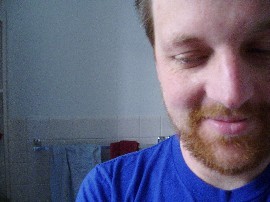Greg Davis

Greg Davis reside en Chicago. Estudió composición y jazz en la Universidad de DePaul en donde conoció la música concreta, electroacústica, la utilización de cintas y la música clásica. Después de graduarse realiza un Magíster en composición en el Conservatorio de Música de Nueva Inglaterra, Boston.
Se inicia en 1995 como guitarrista en un programa de jazz de DePaul y luego agrega como soporte el software musical y los ritmos de la Intelligent Dance Music [IDM], lo que también complementó con el folk, la electroacústica y los registros de campo. Esto último quedó plasmado en su anterior disco “Curling Pond Woods” [Carpark, 2004].
Debutó con un 7” en Grounded y luego le siguieron dos discos en Carpark; una actuación de live electronics en Holanda en la serie “Mort Aux Vaches” del sello Staalplaat y otro 7 pulgadas en el sello alemán Tonschacht y el nuevo álbum y debut en Kranky, “Somnia” que muestra el interés de Davis por la drone music, cuestión que había explorado en sus incursiones anteriores en laptop. Más info. en los sitios de los sellos [www.kranky.net](http://www.kranky.net) y en el sitio de este artista [www.autumnrecords.net](http://www.autumnrecords.net)
Greg Davis is a Chicago based musician who studied composition and jazz at the DePaul University where he studied musique concrète, electroacoustic, tape music and classical. After graduating he earned a Master’s in Composition at the New England Conservatory of Music in Boston. He started in 1995 as a guitarist in the jazz program of DePaul and soon adds the audio musical software as another instrument and the IDM beats, which also was complemented with folk, electroacoustic and field recordings. This was shaped in his previous ‘Curling Pond Woods’ album released on Carpark also this year.
He made a debut with a 7″ on Grounded and soon followed two albums on Carpark; a performance of live electronics in Holland in the series «Mort Aux Vaches» of the Staalplaat Dutch label and record shop now based in Berlin, besides a 7 inches in the German Tonschacht imprint and the new album and debut on Kranky, ‘Somnia’ that showcase interest in drone music, already explored in his previous incursions on laptop. More info. in the labels’s sites at [www.kranky.net](http://www.kranky.net) and at the artist web site [www.autumnrecords.net](http://www.autumnrecords.net)
**Creo que el álbum “Somnia” [Kranky 2004] es tu disco más introspectivo hasta ahora. ¿Tuviste un concepto especial para este disco?**
“No hubo en realidad un concepto detrás este disco ya que los temas fueron hechos separadamente a lo largo de casi tres años. El único tema o hilo conductor a través del disco es que toda la música son piezas de drone o composiciones casi estáticas. También cada tema utiliza un solo instrumento como fuente de sonido. Mantuve esta regla en todo el disco”.
**Dado que estás interesado en los sonidos orgánicos y su procesamiento por los software de audio. ¿Cuáles fueron las transformaciones más interesantes de los instrumentos que tu utilizaste?**
“Utilicé el efecto digital del time stretching [que permite comprimir o prolongar la duración de un sample] y el proceso de síntesis granular en ‘Somnia’. Y luego tras agregar capas y transponer y editar partes, fui capaz de hacer un rico tapiz de sonidos. Cada instrumento prestó un tipo de procesamiento específico y diferente. Creo que el más interesante y la transformación más abstracta tuvo lugar con la caja de música en el tema ‘Mirages’. Utilicé un proceso espectral con el cual me permitió visualizar los sonidos gráficamente y tocar sobre ellos y alterar la visualización gráfica y luego resintetizar esa gráfica a sonido. El resultado final es bastante distinto de los bellos sonidos staccato tintineantes de la caja de música, pero aún mantiene el mismo carácter armónico y el tono del color”.
**¿Cuál es tu enfoque con los registros de campo? ¿Los utilizaste en “Curling Pond Woods” [Carpark, 2004] pero no en “Somnia”?**
“Hago registros de campo en todos mis viajes y giras alrededor del mundo. Recientemente hice unos verdaderamente magníficos registros de campo en Australia de pájaros y murciélagos y emu [ave grande] y sapos, etc. Estoy solo muy interesado en grabar paisajes sonoros naturales o objetos o animales. No me interesa demasiado en los sonidos urbanos porque constantemente estoy rodeado por ellos y no son interesantes para mí a nivel de sonido. También he comenzado una serie de CD-R’s que se llama ‘Leaves’ en mi sello Autumn Records. Es para editar solo registros de campo e improvisaciones con sonidos básicos. Estoy hasta ahora muy contento con la serie porque me ha dado una salida solo para mis trabajos de registros de campo. La razón por la que no utilicé registros de campo en ‘Somnia’ es porque quería hacer un disco de puros drone. Quería apegarme a la regla que sólo estaba utilizando un instrumento como fuente de sonidos para cada tema. Entonces mantuve esta disciplina. Ciertamente no quiero utilizar los registros de campo en cada pieza musical que haga. Es un sonido especial que es utilizado cuando necesito un cierto sonido o textura o espacio o sensación”.
**Mi tema favorito en “Somnia” es “Diaphanous [edit]”, aunque en mi percepción no suena como un piano eléctrico Fender. ¿Cómo lograste este sonido especial?**
“‘Diaphanous’ fue hecho en realidad con una armónica de juguete. Tomé una corta melodía y la sometí por harto tiempo a time stretching, transposición y agregar capas. Creó una pieza simétrica por lo cual la segunda mitad de la pieza es una imagen espejo de la primera. También utilicé diferentes reverberaciones y delays [entre otras cosas] para procesar los sonidos de la armónica. Sólo para ser directo aquí están los instrumentos utilizados en los temas [quizá no están tan claros en el disco promocional]: ‘Archer’ = bowed psaltery; ‘Clouds as edges’ = guitarra acústica de 6 cuerdas; ‘Diaphanous’ = armónica de jugueta; ‘Campestral’ = Piano Fender Rhodes; ‘Furnace’ = órgano de cuerdas; ‘Mirages’ = Caja de música Punch card”.
**¿Cuáles sonidos te gustaría [seguir] explorando?**
“Todos ellos”.
Texto: Guillermo Escudero
Noviembre 2004
**I feel ‘Somnia’ it’s your most introspective to date. Did you have an special concept behind the making of this album?**
“There wasn’t really a concept behind this record as the tracks were made separately over the course of 3 years or so. The only theme or thread throughout the record is that all the music is drone pieces or mostly static compositions. Also each track uses only 1 single instrument as a sound source. I kept this rule throughout the record.”
**As you are interested in organic sounds and its processed by audio software programs. Which were the most amazing transformations that occurred in the instruments you used?**
“I used a lot of time stretching and granular synthesis processes on ‘Somnia’. And then by layering and transposing and editing parts, I was able to make a rich tapestry of sounds. Each instrument lent itself to a different and specific kind of processing. I feel that the most interesting and abstracted transformation took place with the punch card music box on ‘mirages’. I used a spectral process whereby I was able to visualize the sounds graphically and then play around with and alter that graphic visualization and then resynthesize that graphic back into sound. The end result is quite removed from the tinkly beautiful staccato sounds of the music box, yet it still retains the same harmonic character and tone color.”
**Which is your approach to field recordings? You used them for ‘Curling Pond Woods’ [Carpark, 2004] but not in ‘Somnia’?**
“I make field recordings on all of my travels and tours around the world. I recently made some really nice field recordings in Australia of bell birds and bats and emu and frogs, etc. I’m really only interested in recording natural soundscapes or objects or animals. I’m not too interested in urban soundscapes because I am constantly surrounded by those sounds and they are not sonically interesting to me. I have also started a CD-R’s series called ‘Leaves’ on my Autumn Records label. It is for releasing pure field recordings and sound based improvisations. I’m very happy with the series so far and it has given me an outlet for my pure field recordings work. The reason I didn’t use field recordings on ‘Somnia’ is that I wanted it to be a pure drone record. I wanted to stick to the rule that I was only using 1 instrument as the sound source for each track. So I kept that discipline. I certainly don’t want field recordings to be used on every piece of music that I make. It’s a special sound that is used when I need a certain sound or texture or space or feeling.”
**My favorite ‘Somnia’ track is ‘Diaphanous [edit]’, although in my perception it doesn’t sound as a Fender Rhodes electric piano. How did you achieve this especial sound

